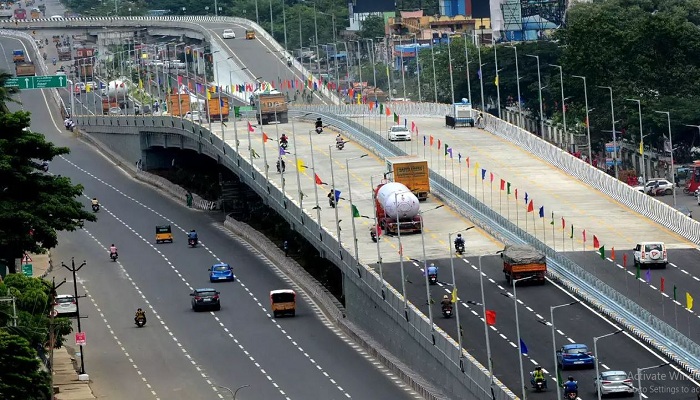
The Challenges in Flyover and Bridge Construction
Published On: 25-11-2024 | 4 min Read
Flyover and bridge construction is a complex process that involves a myriad of challenges across design, construction, maintenance, and social spheres. Addressing these issues requires a multi-disciplinary approach, incorporating advanced engineering techniques, rigorous planning, and effective stakeholder engagement. By recognizing and tackling these challenges, civil engineers can build safer, more durable, and more efficient infrastructure that stands the test of time and serves the needs of communities for generations to come.
In civil engineering, flyovers and bridges are the formidable routes to construct achievements in infrastructure. They guide the traffic flow seamlessly, connect distant worlds and signify present-day mechanical capacity. Yet building these critical faculties is fraught with difficulties. It is a labyrinth of technical, environmental and social issues from planning to execution. So this further explores some of the major challenges that flyover & bridge construction face, and how engineers/Planners can overcome them.
1. Design and Planning Challenges
Complexity of Design: Designing a flyover or bridge is no small feat. Engineers must balance structural integrity, aesthetics, and functionality while accommodating various environmental and logistical constraints. The choice of materials, load-bearing requirements, and the bridge's lifespan all need meticulous consideration. For instance, the design of a suspension bridge involves complex calculations of tension, compression, and stress, which must be accurately modeled to ensure safety and durability.
Regulatory and Safety Standards: Compliance with local, national, and international safety standards is critical. Engineers must adhere to stringent guidelines to prevent failures and ensure the safety of both the structure and its users. Adapting designs to meet evolving regulations can be challenging, especially when working with outdated or inconsistent codes.
Environmental Impact: Assessing and mitigating the environmental impact is crucial. The construction of bridges and flyovers can disrupt local ecosystems, affect wildlife habitats, and lead to pollution. Engineers need to conduct thorough environmental impact assessments (EIAs) and integrate sustainable practices into their designs to minimize these effects.
2. Construction Challenges
Geotechnical Issues: The foundation is the bedrock of any bridge or flyover, and its stability depends on the underlying soil and rock conditions. Poor geotechnical assessments can lead to foundation failure, subsidence, or settlement issues. Engineers must perform detailed soil investigations and adapt their designs to the specific geotechnical conditions of the site.
Material Quality and Availability: The quality and availability of construction materials can significantly impact the project's success. Variations in material quality can lead to structural weaknesses and longevity issues. Ensuring a consistent supply of high-quality materials and managing potential shortages is a critical aspect of construction management.
Construction Techniques and Equipment: Modern construction techniques, such as incremental launching, cantilevering, and pre-stressed concrete methods, require specialized equipment and expertise. Any failure in the equipment or technique can lead to delays, increased costs, or structural defects. Ensuring that construction teams are well-trained and that equipment is regularly maintained is essential for smooth operations.
Weather and Natural Disasters: Weather conditions and natural disasters pose significant risks during construction. Heavy rains, high winds, and extreme temperatures can affect construction schedules and safety. Contingency planning and designing structures to withstand environmental stresses are crucial to mitigating these risks.
3. Operational and Maintenance Issues
Long-term Durability: Ensuring the long-term durability of bridges and flyovers is a major concern. Exposure to traffic loads, weather conditions, and environmental factors can lead to wear and tear. Regular maintenance and inspections are necessary to identify and address issues like corrosion, cracks, and joint deterioration before they escalate.
Traffic Management: During construction, managing traffic flow and minimizing disruptions can be challenging. Implementing effective traffic management plans, including detours and clear signage, is essential to maintaining safety and minimizing inconvenience for road users.
Cost Overruns: Budget overruns are a common issue in large-scale construction projects. Unforeseen complications, design changes, and delays can lead to increased costs. Effective project management, clear budgeting, and risk assessment can help control expenses and avoid financial strain.
4. Social and Community Impact
Public Displacement: The construction of flyovers and bridges can lead to the displacement of communities, businesses, and local amenities. Addressing the social impact and providing adequate compensation or relocation options are important for maintaining public support and minimizing negative effects on local residents.
Community Engagement: Engaging with the community and addressing their concerns is crucial for the successful implementation of infrastructure projects. Public consultations and transparent communication can help garner support and address any objections or issues that arise.